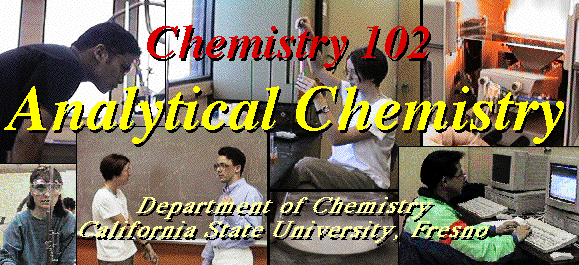
Catalog Description: 102. Analytical Chemistry (5) For chemistry majors; recommended for other science majors. Prerequisites: Chem 1B (with a grade of C or better), 128A, and Math 76. Students with credit in a similar lower-division quantitative analysis course will receive only one additional unit of credit. Introduction to principles and methods of analytical chemistry. (3 lecture, 6 lab hours).
The following documents are available for Spring 1997
Syllabi and Schedules
Tutorials and Study Guides
- A Survival Guide for Analytical Chemistry
- A Tutorial on Linear Least Squares Analysis
- Directions for Statistics on Calculators
- Advanced Methods Tutorial on Solubility Product Problems
- Calculating Theoretical Precipitation Titration Curves
- A Tutorial on Gran's Plotting for End Point Detection using Potentials
- A Tutorial on Gran's Plotting using pH. Includes Volume Intercept Error Analysis
- Derivative Methods for End Point Detection--Includes Error Estimation
- Calculating Titration Curves with Initial/Final Spreadsheets
- A Study Guide for Analytical Separations
The Overhead Gallery
- The Survival Guide Acid-Base Equations, with Extended Formulas
- The Common Buffer Problems
- Polyprotic Acid-Base Problems--The Quick and Dirty Method
- Complex Formation Equilibrium Problems--Calcium with EDTA
- Spectrophotometric Errors: Choosing the Best Concentration Range
- The Integral Fast Reactor An example of electrochemical separation and energy politics. See also the interview with Dr. Charles Till from the Frontline program "Nuclear Reactions" of 4/22/97 at The PBS Home Page.
- HPLC Chromatograms at Varying Solvent Composition
Laboratory Helps and Procedures
- Chemistry 102 Lab Notes
- Organizing the First Two Weeks of Lab
- Directions for Drying and Weighing
- See the EDTA end point color change
- Using the GBC 902 Atomic Absorption Spectrophotometer
Answers to InClass Problems
- InClass01 Basic and Gravimetric
- InClass02 Statistics
- InClass03 Solubility Product
- InClass04 Acids and Bases
- InClass05 Complex Formation and pH Effects
Other Sites of Interest
For questions or comments contact:Dr. David L. Zellmer, Ph.D.
Department of Chemistry
California State University, Fresno
Fresno, California 93740Office: Science Building, Room 244
Telephone and Voice Mail: (209) 278-2113
Chemistry Dept. Office: (209) 278-2103
E-mail: david_zellmer@csufresno.eduThis site was last updated on 7 May 1997.